
The Future of Leadership Survey: 2023
Friday, November 3, 2023
The Seton Hall University Stillman School’s Department of Management research team presents the results of its third annual, Institutional Review Board-approved “The Future of Leadership Survey: Insight and Foresight About the Future of Leadership from the Leaders of the Future.”
Executive Summary
The Research Team launched this longitudinal research in 2021 to pointedly examine the leadership insights and foresight of those entering their professional lives. Before that, leadership research tended to center on C-suite executives, either on their own behaviors or as observed by those who report to them or by other stakeholders. There was a significant gap in the literature on how the next generation viewed leadership and how best to develop the leaders of tomorrow. This, we believed, was a serious omission in research for two reasons. First, organizations needed guidance on how they may want to respond to the leadership aspirations and expectations of tomorrow’s professionals. Second, there was a dearth of guidance on how to develop the leaders of tomorrow based on their own wants.
Recognizing the connectedness of organizations globally, this year we took an important and critical step in expanding our research worldwide. In addition to Seton Hall University students and alumni, the survey was distributed to the target segment across the United States, Canada, Mexico, Brazil, China, Japan, Singapore and the European Union 5 (France, Germany, Italy, Spain, United Kingdom). We undertook the first step in understanding leadership from colleagues on the African continent by surveying a small subset of leaders in Nigeria. We received 5,327 valid responses, providing us with a robust data set to conduct our analysis.
The findings from the survey are intriguing. While mainstream news media are full of stories regarding the hesitation of employees to be back in the office and relative job dissatisfaction and leadership challenges, the survey findings present a different picture. The results indicate 70 percent of employees work remotely less than 50 percent of the time; which means 70 percent of the respondents are in the office at least three days a week. This is in stark contrast to what news reports seem to indicate.
Further, we find that according to the respondents, remote work has not impeded productivity, nor has it impacted their leadership development, nor is the lack of it a primary cause of job dissatisfaction. The primary cause of job dissatisfaction around the world is salary.
The results should give employers pause. The results indicate that the emerging workforce is keeping pace with and has adapted well to a hybrid work environment. This cohort believes that the employers are providing them with good development opportunities and want more. Rather than forcing workforce policies of the pre-pandemic era, employers will be well-served to meet the emergent workforce where is, and it can be a win-win situation for all.
Research Design
In 2023, the research team decided to broaden the age group of target respondents from 18-25- to 18-30-yearolds. From the 2021 survey, we had preliminary data that signaled that work experience moderated insights and foresight on leadership. With the 2022 survey, we were not able to confirm the impact, as our dataset did not have an adequate sample size of those with work experience to draw statistically valid conclusions.
To enhance the insights, in the third survey we expanded the respondent base to include 18-30-year-olds to get an adequate sample of the generation getting ready to enter the workforce and also to obtain insights from those who have already gained some work experience.
The overall objectives of the survey remained consistent:
- To better understand the expectations of future leaders — college students and recent graduates — regarding the leaders they seek to work with or want to become.
- To develop insight and foresight on values, competencies and preferred models of leadership development for the future.
The survey started with a self-reflection on traits noted in leadership literature. We again asked about the relevant physical traits of leaders, nested in the prior traits research, some of which are over 50 years old.
The next set of questions focused on the values, character and competencies of mid-level leaders, and the challenges they face. These questions were posed to obtain a form of leadership trajectory for young leaders. In other words, we would learn the competencies and values that would be important in a leadership position they envisioned 10 years or so into their own future, as well as the competencies and values they would be seeking from their own boss.
There was also a series of questions posed on how best to develop leaders of tomorrow. The survey again probed the impact of remote work on leadership development. The team also surveyed the respondents on their job satisfaction to understand what leadership dimensions affect this the most.
Finally, respondents replied to a set of demographic and work experience questions. In February 2023, survey respondents across the globe were sent electronic copies of the survey, translated into local languages. For Nigeria, 10 interviews were conducted over the phone using the same survey instrument.
Seton Hall University’s social media accounts were leveraged to invite responses, and several reminders were also sent. Over 5,300 completed surveys were returned, with the results tabulated in aggregate at global and regional levels. (While respondents from Nigeria had the highest scores overall, we have excluded them from the overall analysis, given the very small sample size.)
Insight #1
Personality self-reflection seems to bode well for nurturing leaders of tomorrow. The self-refection questions that we asked are based on the Big 5 profile model proposed by L.R. Goldberg, J.A. Johmon, H.W. Eber, R. Hogan, M.C. Ashton, C.R. Cloninger and H.C. Gough in “The International Personality Item Pool and the Future of Public domain Personality Measures,” Journal of Research in Personality 40 (2004), pp 84-961. At the global level, the respondents exhibit a high level (score above 8) of openness to new experiences — 8.20 (I enjoy hearing about new ideas, and I enjoy thinking about new things). The respondents exhibit a moderate level (score between 6-8) of agreeableness — 7.94 (I sympathize with other people’s feelings, and I take time out for others), conscientiousness — 7.75 (I am always prepared, I pay attention to details), emotional stability — 6.72 (I am relaxed most of the time, I am not easily bothered by things) and extraversion — 6.67 (I talk to many different people at parties, and I don’t mind being the center of attention).
Respondents whose primary work location is China, Japan and Singapore scored highest on extraversion and emotional stability. Respondents from Mexico and Brazil scored the highest on openness to new experiences and conscientiousness, while respondents from the United States and Canada scored highest on agreeableness.
Analyzing the data by gender, both males and females scored equally on conscientiousness. Males scored higher on extraversion and emotional stability (moderate levels), while females scored higher on agreeableness and openness (high levels). Respondents with experience greater than one year scored higher on all dimensions compared to respondents with less than one year of work experience. On the other hand, supervisory experience increased the scores on extraversion, conscientiousness and emotional stability, while reducing the scores on agreeableness and openness. Remote work did not seem to affect the profile traits.
The literature suggests that leadership success has been known to correlate with high levels of openness and conscientiousness. Further, “extraversion has proven to have strong predictive validity of leadership in a position following a job interview. (Salgado, 1997).” The survey data suggests that the leaders of the future have the raw materials to be successful leaders — especially as conscientiousness has scored high across regions, gender, years of work experience and supervisory experience, while the personality traits of openness and extraversion are present in healthy doses.
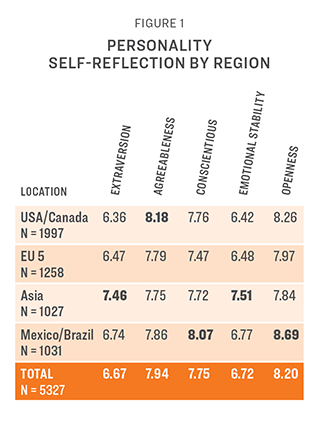
Insight #2
Attitudes toward physical traits converge globally. The 2021 and 2022 survey results indicated acceptance of diversity in the ranks of future leaders, with an expectation that leaders are well-attired, healthy and with well-groomed hair. Gender, race and ethnicity-related physical characteristics did not rank as high for this generation. The findings from the survey allowed the team to contribute to the national discussion on the CROWN Act of 2022 (Creating a Respectful and Open World for Natural Hair Act of 2022) and the Future of Work.
Yet again, the respondents overwhelmingly ranked controllable attributes of physical appearance — attire, health and hair — as important attributes of a leader. Genetic traits such as height and voice are not emphasized as important. The results are consistent globally and at regional levels, with Asia putting a little bit more emphasis on attractiveness over well-groomed hair.
Based on the responses, we infer that employees still view their leaders as figureheads of the firm and are the face of it to the public. That figurehead role demands that leaders convey a presence regardless of whether the respondent is a man or woman and regardless of race.
We are heartened to see that leaders of tomorrow have moved beyond the superficial physical traits of leaders, such as those centered on height and more. Nonetheless, wearing the leadership mantle carries with it expectations about how those leaders present themselves to their many stakeholders. Our message to future leaders remains loud and clear: invest in appropriate attire, stay well groomed, and please, take care of your health. Invest in diet and exercise.
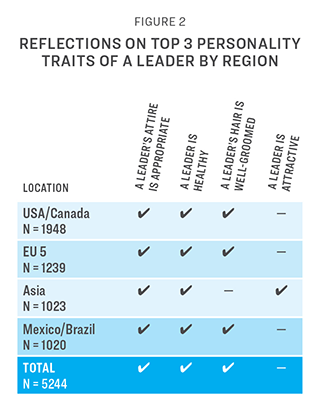
Insight #3
Future leaders face higher volatility and uncertainty. When surveyed on what the respondents look for when hiring their immediate supervisor, we notice convergence in the values and character traits expected from a leader at the global level. The most desired values and character traits are “admits mistakes,” “recognizes the dignity of employees,” “is a continuous learner” and “is ethical.” Additionally, European respondents want leaders to “encourage open dialog.” Asians also want leaders to “seek diverse perspectives” and “pursue excellence.”
Surprisingly, “driven by higher purpose” has been ranked the lowest across all geographies, except for Asia. This is in stark contrast to the significant emphasis on purpose in leadership literature today. Our hypothesis is that the responses are indicative of the volatile business environment where rapid change, shifting priorities and high employee turnover require leaders to be continuously learning, treating employees with respect and remaining ethical.
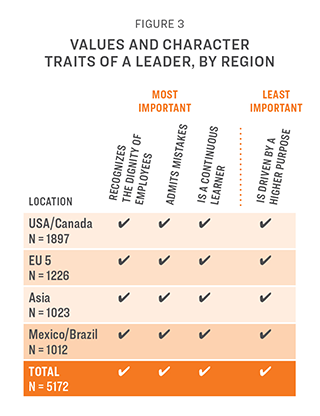 A review of key challenges faced by leaders confirms our hypothesis — that “dealing
with crisis and failure,” “managing work-life balance” and “creating an environment
where employee work is valued” are the key challenges facing leaders today.
A review of key challenges faced by leaders confirms our hypothesis — that “dealing
with crisis and failure,” “managing work-life balance” and “creating an environment
where employee work is valued” are the key challenges facing leaders today.
An examination of competencies required of future leaders affirms the hypothesis that future leaders need to be prepared for leading in a rapidly changing world. A view of the pattern that emerges at a global level indicates that future leaders need to be able “to cope with and adapt to stressful situations,” and be critical thinkers, collaborators and communicators, innovators, and change agents.
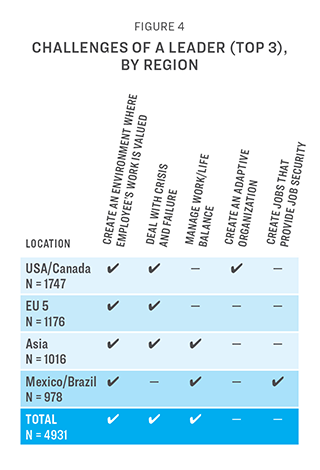
Insight #4
Early data suggests that leadership development is normalizing in hybrid work arrangements. We surveyed the respondents to understand what percent of their work was remote over the past 12 months. Despite the impression created by the news stories that employees are hesitant to come back to offices, 43 percent of the survey respondents reported less than 25 percent remote work — which translates to approximately one day of remote work.
Another 31 percent reported remote work to be between 26-50 percent, which translates to about two days of remote work. Only 26 percent of the respondents reported more than 50 percent of their work being remote. It is, therefore, safe to conclude that 75 percent of the survey respondents are in the office three or four days a week. (See Figure 1)
Looking across regions, we see consistency in a high percentage of respondents reporting less than 50 percent of their work being remote, except for the respondents in Asia, where the percentage is slightly lower but still predominantly less than 50 percent of the work being remote.
In the 2022 survey, 60 percent of respondents based primarily in the United States reported less than 50 percent of their work being remote. The 2023 data suggests that the percentage of remote work has decreased overall, as 75 percent of the respondents based in North America now report less than 50 percent of their work being remote. (See Figure 2) What is interesting is that when asked whether remote work has affected their leadership development, in 2023, 59 percent of the respondents said yes and 41 percent said no. (See Figure 3)
This is in contrast to the results from the 2022 survey, where 76 percent of the respondents indicated that they experienced a lack of leadership development because of the pandemic — which was characterized by a higher percentage of work being remote, with the caveat that the 2022 survey respondents were primarily from the United States.
The 2022 survey respondents also indicated that if firms manage to keep remote work to less than 50 percent, there was a slight positive uptick in certain leadership growth dimensions. However, if employees experience more than 50 percent of their work remotely, a negative impact on leadership development was observed.
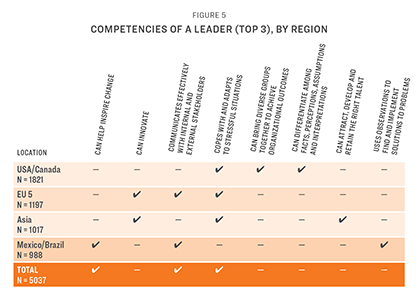
What becomes very interesting is that when asked to rank how valuable the various approaches have been in their ability to advance their leadership competencies in this work environment, looking at the pattern across the globe, “the ability to be exposed to leadership communication,” “the ability to be exposed to collaborative work” and “the ability to be exposed to opportunities that extend beyond one’s comfort zone” ranked the highest.
In 2022, the respondents (albeit primarily U.S. based) noted that the above three approaches to leadership development were negatively affected by the pandemic.
The conclusion that can be drawn from this observation is that while it may have taken
employers a couple of years to of hybrid work, they have adapted well and are doing
many things right — the leaders are communicating effectively, there is enough collaborative
work, and people are getting enough work opportunities to stretch beyond their comfort
zones. This bodes well for employer-based leadership development.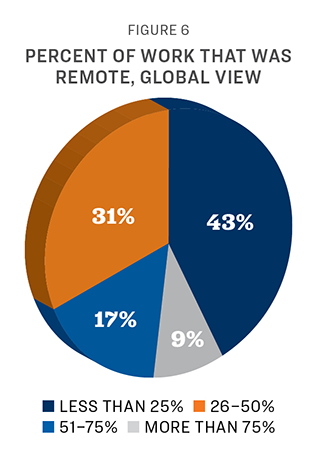
Insight #5
70 percent of the employee base is at risk of attrition at any time. At the same time, when asked “to what extent have you considered leaving your job
in 2022 versus 2021,” an astonishingly high 30 percent responded, “More.” What is
also interesting to note is that only 30 percent said “Less,” which means 70 percent
of the employee base of a company is at risk of attrition at any given time. This
cannot be good for any company, its morale, its productivity or its competitiveness
in the market. (See Figure 4)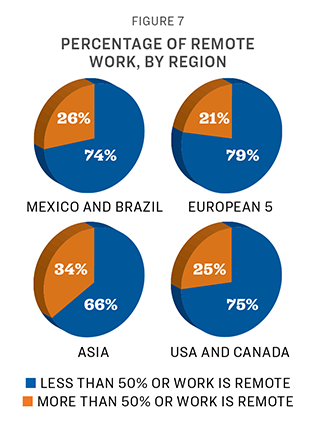
What is confounding is that when asked how much the respondents agreed with various statements that were presented, the respondents moderately agreed with the following: “my work can make an impact,” “I am loyal to my employer,” “I have control over my work,” “I am satisfied with the feedback that I receive,” and “I am satisfied with the time required to be physically present in the office.”
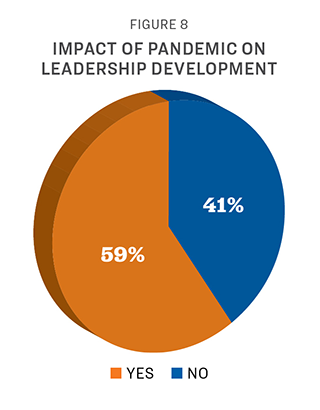 The three statements where the respondents are least agreeable are: “I am satisfied
with my salary,” “I feel my employer is concerned about my mental health,” and “I
feel my employer takes steps so I don’t feel burnt out.” Further analysis reveals
that salary is the primary factor for respondents considering changing jobs.
The three statements where the respondents are least agreeable are: “I am satisfied
with my salary,” “I feel my employer is concerned about my mental health,” and “I
feel my employer takes steps so I don’t feel burnt out.” Further analysis reveals
that salary is the primary factor for respondents considering changing jobs.
Based on the data at this point in time, we can make the following inferences about the current work environment as viewed from the perspective of our target respondents — 18-30-year-olds:
- The workforce is less loyal, with 70 percent of respondents reporting that they have considered leaving their job the same or more than the previous year.
- Dissatisfaction with salary is the primary factor that is driving this sentiment.
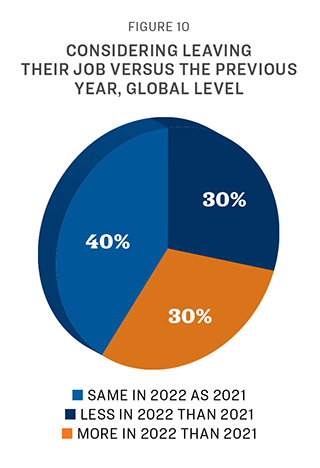 On one side, this is indicative of a growth economy that is offering workers multiple
choices. On the other, it does not behoove well for organizations if they must face
a high rate of churn as a result. It might be beneficial for employers to consider
increased salary incentives to retain the current workforce, balancing it against
the cost of constant hiring, workforce development, leadership development and succession
planning.
On one side, this is indicative of a growth economy that is offering workers multiple
choices. On the other, it does not behoove well for organizations if they must face
a high rate of churn as a result. It might be beneficial for employers to consider
increased salary incentives to retain the current workforce, balancing it against
the cost of constant hiring, workforce development, leadership development and succession
planning.
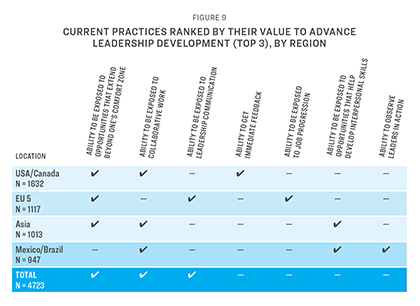
Insight #6
Employers must take center stage as the locus of leadership development. When it comes to preferences on methods of leadership development, the employer takes center stage. At a global level, respondents have ranked internships and structured undergraduate and graduate-level leadership programs as the top three preferred choices. This affirms our recommendation from prior surveys that universities have a critical role to play in developing leaders of the future and will be well-served in developing and offering such programs.
Many U.S.-based universities already do that, including Seton Hall through its Buccino Leadership Institute. However, a closer look at the pattern where we picked the preferences most ranked in the top five, “internships/externships,” “assigned mentors from industry or employer,” “constructive, just-in-time multistakeholder feedback,” “on-the-job leadership coaching sponsored by employers” and “structured leadership development programs sponsored by the employers” emerge as the top preferences.
Employers therefore will be well-served to continue to invest in the leadership development of their employees.
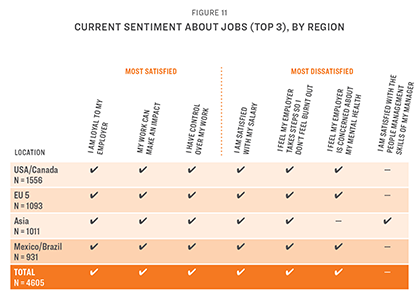
Conclusion and Path Forward
We are delighted that we have the benefit of more than 5,300 global data points in this year’s survey. Based on the findings described above, it is fair to conclude that we are looking at a global workforce that is more similar than not. At a macro level, the dominant personality traits of the respondents include their openness to new ideas and their agreeableness. They score lower on the traits of extraversion and emotional stability.
The workforce wants its leaders to represent them, so, in turn, has expectations that leaders will be well-groomed, well-attired and healthy. It wants leaders who have a learning mindset and can deal with constant change with empathy. It seems to have adapted well to remote work, which is not excessive in the first place based on the respondent set. It does feel that their employers are doing many of the right things — providing both meaningful, impactful work and development opportunities.
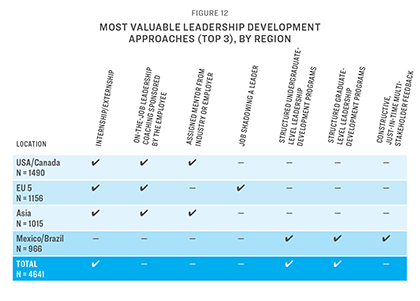
The employees also see their employers as the loci of leadership development and want the employers to invest more.
The fact that 70 percent of respondents reported that they considered leaving their job the same or more in the last year is an area of concern because an unhealthy, disengaged workforce cannot be good for any organization. The good or bad news is that the primary factor driving this behavior is salary. Companies need to take this to heart, conduct a cost-benefit analysis on offering higher salaries for talent retention and orient their human capital strategies accordingly.
While we have reported only global level findings in this report, the data also gives us insights into trends by region, gender, race, work and supervisory experience. Our intent is to uncover significant insights at the regional level that build upon the global level insights presented here.
Acknowledgment: We are grateful to our partners Awais Majeed, Steven Scott and Alex McAuley at Atheneum for making the global survey a reality for us. Their global outreach was key to collecting global data at such a large scale in such a short time. We would also like to thank Samah Alshrief, Ph.D., for her work in supporting the data analysis related to this research.
This article originally appeared in the Fall 2023 issue of In the Lead magazine, from Buccino Leadership Institute. The bi-annual magazine focuses on leadership perspectives from the field of health care, with content that is curated from leaders across the industry who share lessons learned from real-world experiences.
